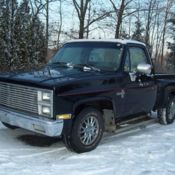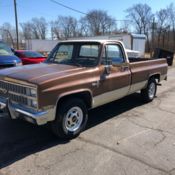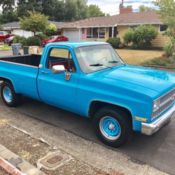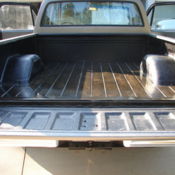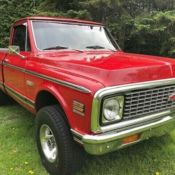1981 Chevy Cheyenne C20
| Condition: | Used |
| Make: | Chevrolet |
| Model: | C/K Pickup 2500 |
| SubModel: | C20 Cheyenne |
| Type: | Pickup Truck |
| Doors: | 2 |
| Year: | 1981 |
| Mileage: | 76347 |
| VIN: | 1GCGC24W3BZ120471 |
| Color: | Blue |
| Fuel: | Gas |
| Transmission: | Automatic |
| Drivetrain: | Rear Wheel Drive |
| Interior color: | Black |
| Vehicle Title: | Clear |
| Item location: | San Diego, California, United States |
| Extras |
| Listed by | Private seller |
Description of 1981 Chevrolet C/K Pickup 2500 C20 Cheyenne |
|
1981 Chevrolet Pickup C20 Cheyenne 1OWNERAMAZING CONDITION 1981 CHEVROLET C20LOW MILESAC WORKSGREAT COLLECTOR TRUCKDRIVES LIKE A DREAMTRANSMISSION SHIFTS PERFECTLYNO MAJOR LEAKSNO MAJOR DENTSNO MAJOR DINGSNO MAJOR SCRATCHESFREE CARFAX INCLUDEDTIRES IN GREAT CONDITIONCALL CORNELIUS WITH ANY QUESTIONS AT: (858) 361-6050EMAIL ME AT: corn@automotive-excellence.net Third generation 1973–1987 Third generation Overview Alsocalled Chevrolet ScottsdaleChevrolet Custom DeluxeChevrolet Silverado Production 1973–1987 Assembly Atlanta, eorgiaBaltimore, arylandPontiac, ichiganFlint, ichiganTarrytown, new YorkKansas City, issouriSt. Louis, issouriJanesville, isconsinNorwood, hioFremont, aliforniaOshawa, ntarioCórdoba (Argentina)Tehran, ran (1977–1982) [10]Arica, hile (1978–1988) Powertrain Engine 250cuin (4.1L) I6292cuin (4.8L) I6262cuin (4.3L) V6305cuin (5.0L) V8350cuin (5.7L) V8400cuin (6.6L) V8454cuin (7.4L) V8350cuin (5.7L) Oldsmobile DieselV8379cuin (6.2L) Detroit Diesel V8 Transmission 3-speed Turbo Hydra-Matic 350automatic3-speed Turbo Hydra-Matic 400automatic4-speed Turbo Hydra-Matic 700R4automatic3-speed Saginaw manual4-speed Saginaw Muncie SM465 manual4-speed New Process NV833 overdrive manual Dimensions Wheelbase 117.5in (2,984mm)135.5in (3,442mm)164.5in (4,178mm) Length 191.5in (4,864mm)(1973–75)191.3in (4,859mm)(1987)211.8in (5,380mm)[11] Height 69.8in (1,773mm) Facelifted GMC C/K 1979 Chevrolet C-20 Custom Deluxe Crew Cab with added camper An all-new clean sheet redesign of General Motors' Chevrolet and GMC brand C/K-Series pickups débuted in mid-1972 for the 1973 model year. Development of the new third-generation trucks began in 1968 with vehicle components undergoing simulated testing on computers before the first prototype pickups were even built for real world testing.[12] The redesign was revolutionary in appearance at the time, articularly the cab, eparting from typical American pickup truck designs of the era. Aside from being near twins, he Chevrolet and GMC pickups looked like nothing else on the road.[13] The third-generation trucks are officially known as the "Rounded-Line" generation.[14][15][16][17] GM's "Rounded-Line" moniker highlighted the pickup's rounded-lines or rounded styling cues that were incorporated into the design. These rounded-lines included rounded windshield corners, ounded cab roof, loped rounded doors which cut high into the cab roof eliminating roof height, ounded front fenders, nd rounded pickup box corners which allowed for rounded or curved wraparound taillamps, first for GM pickups. The design also featured strong distinctive curved shoulderlines which rounded out below the beltline.[14] The curved shoulderline continued across the back tailgate on Chevrolet Fleetside and GMC Wideside models. A popular, ut incorrect nickname for these trucks is "square body", ropagated through truck magazines and word of mouth for the perceived rounded-rectangle profile of the front cap of the body. As this name did not originate from General Motors, t is therefore not official. GM's design engineers fashioned the "Rounded-Line" exterior in an effort to help improve aerodynamics and fuel efficiency, sing wind tunnel technology to help them sculpt the body.[18] Other design traits include "double-wall" construction, leek sculpted body work, aerodynamic cab with steep windshield rake, nd a unique available hidden radio antenna embedded into the windshield glass.[14][19][20] There were two types of pickup boxes to choose from. The first type, alled Fleetside by Chevrolet and Wideside by GMC, as a "double-wall" constructed full width pickup box and featured a flared shoulderline to complement the cab in addition to rounded box corners and the new aforementioned rounded wraparound taillamps. Both steel and wood floors were available. The second type, alled Stepside by Chevrolet andFenderside by GMC, as a narrow width pickup box featuring steps and exposed fenders with standalone tail lamps. Initially, nly wood floors were available.[21] The wheelbase length was extended to 117.5 in (2,985mm) for the short wheelbase pickups, nd 131.5 in (3,340mm) for the long wheelbase pickups. A new dual rear wheel option called "Big Dooley" was introduced on one-ton pickups, long with a new Crew Cab option on the 164.5in (4,178mm) wheelbase. An optional Elimipitch camper was made available for the Big Dooley.[22] Crew Cabs were available in two versions: a "3+3" which seated up to six occupants and "bonus cab" which deleted the rear seat and added rear lockable storage in its place. The fuel tank was moved from the cab to the outside of the frame, nd a dual tank option was available which brought fuel capacity to 40 US gallons. 1980 was the first year that a cassette tape player could be purchased, long with a CB radio.[23] The Rounded-Line generation ultimately ran for a lengthy 15 model years (1973–1987) with the exception of the Crew Cab (four-door cab), lazer, immy, nd Suburban versions, hich continued up until the 1991 model year. GM ends this generation with 1987 as 1987 was the last model year for the conventional cabs (two-door cab). Interior and safety[edit]The third-generation pickups were offered in several equipment level packages or trim packages. Chevrolet/GMC used various names for the trim levels throughout the vehicle’s life cycle and some were rearranged in their class order. For the 1973 and 1974 model years, he base (standard) trim level was Custom/Custom, id-range trims were Custom Deluxe/Super Custom, uxury trims were Cheyenne/Sierra, nd top-of-the-line luxury trim levels were Cheyenne Super/Sierra Grande.[12] For the 1975 model year the trim levels were revised and the base trims were now Custom Deluxe/Sierra, id-range trims were Scottsdale/Sierra Grande, uxury trims were Cheyenne/High Sierra, nd the top-of-the-line luxury trim levels were now known as Silverado/Sierra Classic. They remained in this configuration up to the 1991 model year.[21] For the 1982 model year, he luxury trim levels were dropped, eaving the base, idcurange, nd top-of-the-line luxury trim level packages.[24] Soft touch materials were used throughout the passenger cabin, uch as the dashboard, oors (arm rests), teering wheel, nd shift levers. Subtle grained interior panels and bright metal work was used on the inside with high-quality materials also used on the outside, ike chrome, luminium, nd polished stainless steel, articularly on top-of-the-line luxury Silverado or Sierra Classic trim levels. Custom Vinyl vinyl or soft Custom Cloth cloth and velour seating surfaces were used along with fabric headliners, oor inserts, nd plush carpeting, epending on the trim level. Upper class trim levels also used acoustic deadening materials for quieter ride comfort.[25] From model years 1973 to 1977, hestnut wood grain inserts were used on the dashboard and doors for further visual enhancement. The wood grain inserts were replaced by bright brushed aluminiuminserts for model years 1978 to 1987.[26] A Delco AM/FM audio sound system and an all-season climate control system that heated, ooled, leaned, nd dehumidified were optional extras.[27] At its launch in 1972, he Rounded-Line C/K-Series introduced two firsts in safety advancements concerning full-size pickups, nd would later lead a third safety advancement in 1975. The first was the standard passenger-side sideview mirror, nd the second was the energy-absorbing collapsible steering column. Patented by GM and already in use in its cars since 1967, he new energy-absorbing steering column was standard on all C-Series and K-Series models.[12][28][29] The third safety advancement was the introduction of dual front lap-and-shoulder safety belts with emergency locking retractors for outboard occupants in 1975 for the 1976 model year.[30] These replaced the outdated and inadequate lap belts previously used. A center lap safety belt with slack adjustment was provided for the center occupant. Ford and Dodge would follow one model year later adding lap-and-shoulder safety belts to their pickups.[31][32] Other safety features included soft-padded interior panels for appearance and safety, 329 square inches of tempered and laminated safety glass, rismatic rearview mirror, ix turn-signal indicator lamps with asymmetrical flash, our-way hazard function, nd lane departure function.[12][25][33][34] Chassis and powertrain[edit] 1987 Chevrolet C-10 Custom DeluxeThird-generation Rounded-Line C/K-Series pickups gained an all-new, igh tensile strength carbon steel ladder type frame with "drop center" design.[19][35][36] Steering controls included variable-ratio recirculating ballsteering gear with optional hydraulic power assist. Braking controls included front self-adjusting disc brakes with rear finned drum brakes and optional four-wheel hydraulic Hydra-Boost or Vacuum-Boost power assist.[12] Engines choices initially consisted of six or eight cylinder engines with either manual or Turbo Hydra-Matic transmissions.[12] C-Series pickups included two-wheel drive and featured an independent front suspension (IFS) system with contoured lower control "A" arms and coil springs. GM's new Load Control rear suspension system took up residence in the back. The Load Control rear suspension system consisted of a rear live axle with dual stage Vari-Rate multi-leaf springs and asymmetrical (offset) shock absorber geometry, o help sort out any "wheel hop" under heavy loads or hard acceleration.[19] K-Series pickups included either Conventional, ermanent, r Shift-on-the-move four-wheel drive. The latter system was introduced for 1981. Regardless of the type of four-wheel drive system equipped, ll K-Series pickups featured four-corner Vari-Rate multi-leaf springs, ront live axle with symmetrical (inline) shock absorber geometry, nd the Load Control rear suspension system. K-Series pickups also featured an off road oriented design, ith the transfer case bolted directly to the transmission and running gear tucked up as high as possible under the vehicle to reduce the chances of snagging vital components on obstacles, s well as to achieve a low silhouette and optimal ground clearance.[37] Exposed brake lines wrapped in steel were standard, ith underbody skid plate armor optional for further protection. Conventional four-wheel drive pickups featured manual locking hubs and a two-speed dual range New Process 205 transfer case with four drive modes: Two High, our High, eutral, nd Four Low. Two High gave a 0:100torque split, hile Four High yielded a locked 50:50 torque split. Four Low applied reduction gearing. The front and rear propeller shafts were locked at all times in Four High and Four Low. Neutral allowed for flat towing, r use of the power take off (PTO).[38] Permanent four-wheel drive pickups featured a two-speed dual range New Process 203 transfer case with planetary center differential and lock. Five drive modes were provided: High, ow, eutral, igh Loc, nd Low Loc. In High the center differential was unlocked and allowed the front and rear propeller shafts to slip as needed for full-time operation. The system could be manually shifted into High Loc which locked the center differential for a locked 50:50 torque split. Low and Low Loc applied reduction gearing with or without lock, epending on the mode selected. Neutral was also available for use of the PTO.[38] A new Eaton Automatic Differential Lock (ADL) was introduced in 1973 as an optional extra on the Rounded-Line C/K-Series pickups, or the rear hypoid differential. The new automatic locking differential was offered under the G86 code, eplacing the Eaton NoSpin differential, nd eventually replacing the old Positraction limited-slip differential in 1974, t which point it assumed the G80 code.[39] The Eaton ADL featured intelligent differential control via an internal governor which monitored vehicle speed and wheel slip to know when to automatically lock and could lockup 100 percent at or below 20mph (32 kph) increasing tractive effort. The differential lock would unlock and deactivate at speeds above 20mph for safety reasons, uch as the vehicle being on dry pavement.[40] Towing and payload capacity ratings for Rounded-Line C/K-Series pickups varied, epending on how they were configured. Factors such as engine and transmission combination, ifferentialgear ratio, urb weight, nd whether the pickup was two-wheel drive or four-wheel drive decided how much the pickup could safely tow or haul. A properly equipped C-Series half-ton class pickup could tow up to 8,000 lbs (4 tons) of braked trailer, hile a properly equipped C-Series three quarter-ton or one-ton class pickup could tow up to 12,000lbs (6 tons) of braked trailer.[41] Adding four-wheel drive reduced towing capability due to increased curb weight, hich resulted from additional driveline components (transfer case, ront axle, ront differential, ront propeller shaft, nd so on) needed to facilitate four-wheel drive. A properly equipped K-Series half-ton or three quarter-ton class pickup could tow up to 6,500lbs (3.25 tons) of braked trailer, hilst a properly equipped K-Series one-ton class pickup could tow 500lbs more, p to 7,000lbs (3.5 tons) of braked trailer.[41] Heavy-duty towing equipment was available for both C and K-Series pickups, uch as the Trailering Special package (included power steering, prated battery, nd uprated generator), -pin trailer electrics connector, eavy-duty engine oil cooler, eavy-dutytransmission oil cooler, nd a weight distributing trailer hitch.[21][42] For the 1975 model year, he 185hp 400cuin (6.6L) small-block V-8 was added to the line and there was a realignment of Chevy trim levels, long with new grilles and clear/white instead of orange front turn signals. Base models gained a passenger-side woodgrain dash accent and a new plaid upholstery pattern (which would change slightly each year until 1978). A new gauge to show voltage replaced the ammeter in 1976, nd the engine size decals were removed from the grille during this model year. For 1977 models, ower windows and power door locks were introduced as an optional extra. There was another round of new grilles, evised inner door panels that left less metal exposed, four-wheel drive, ull one-ton chassis was added to the lineup, nd aDana 60 was used for the front axle, s well as an electric oil pressure gauge replacing the mechanical unit. Trucks with an optional trim level, ut without an additional wheel upgrade, eceived flatter stainless steel hubcaps, till with painted accents. This was also the only year with yellow painted trim instead of black. The addition of the first diesel engine of the three American automakers in a light duty pickup the 125hp 350cuin (5.7L) Oldsmobile diesel V-8 began in 1978. All models got new, latter dash trim panels, lack on the lower two trims and aluminum-look on the fancier two. Base models received the flatter stainless hubcaps, nd Stepsides got new squared-off taillights with built-in backup lights and side markers, hile the rear fenders were smoothed out where the old side markers were. The 1979 models got a new grille surround that incorporated the turn signals; inside there was a new full-width "houndstooth" seat trim on base models and a (rare) fifth interior color option on the higher series called "oyster" by Chevrolet and "Mystic" by GMC (mostly white with a gray dash, arpeting and cloth). Fuel doors were added to the bed sides to hide the previously exposed fuel caps. For the 1980 model year, ermanent four-wheel drive was discontinued on K-Series, eaving only conventional four-wheel drive. Some pickups gained a new grille, thers did not; high-trim Chevys had both a new surround that incorporated near-flush square headlights and revised turn signals with a new, quarer grille pattern, hile a GMC base model was entirely carryover, ase Chevys had the new center section in the 1979 surround while GMCs with uplevel trims or the separate RPO V22 option had the new square-light surround with the main grille introduced in 1977. Blue interiors were a darker shade than before. Engines[edit][43] Year Engine Power Torque Notes 1981–1984 4.1 L GMC 250 I-6 115hp (86kW) @ 3600 RPM 200lb·ft (271N·m) @ 2000 RPM 1983 120hp (89kW) @ 4000 RPM 205lb·ft (278N·m) @ 2000 RPM C1 1985–1986 4.3 L LB1 90º V-6 155hp (116kW) @ 4000 RPM 230lb·ft (312N·m) @ 2400 RPM 1987-1991 160hp (119kW) @ 4000 RPM 235lb·ft (319N·m) @ 2400 RPM 1981–1985 4.8 L GMC 292 I-6 115hp (86kW) @ 3400 RPM 215lb·ft (292N·m) @ 1600 RPM 1986 115hp (86kW) @ 4000 RPM 210lb·ft (285N·m) @ 800 RPM 1981–1982 5.0 L 305 V-8 130hp (97kW) @ 4000 RPM 240lb·ft (325N·m) @ 2000 RPM 2-barrel 1981–1982 165hp (123kW) @ 4400 RPM 240lb·ft (325N·m) @ 2000 RPM 1/2 Ton w/ 4-barrel 1981–1982 160hp (119kW) @ 4400 RPM 235lb·ft (319N·m) @ 2000 RPM all others w/ 4-barrel 1983–1986 165hp (123kW) @ 4400 RPM 240lb·ft (325N·m) @ 2000 RPM less than 8500# GVWR 1983 160hp (119kW) @ 4400 RPM 235lb·ft (319N·m) @ 2000 RPM over 8500# GVWR 1987-1991 170hp (127kW) @ 4000 RPM 260lb·ft (353N·m) @ 2400 RPM 1981–1986 5.7 L 350 V-8 165hp (123kW) @ 3800 RPM 275lb·ft (373N·m) @ 1600 RPM less than 8500# GVWR 1987 210hp (157kW) @ 4000 RPM 300lb·ft (407N·m) @ 2800 RPM 1981–1985 160hp (119kW) @ 3800 RPM 250lb·ft (339N·m) @ 2800 RPM over 8500# GVWR 1986 185hp (138kW) @ 4000 RPM 285lb·ft (386N·m) @ 2400 RPM 1987 185hp (138kW) @ 4000 RPM 295lb·ft (400N·m) @ 2400 RPM 1981–1982 7.4 L 454 V-8 210hp (157kW) @ 3800 RPM 340lb·ft (461N·m) @ 2800 RPM 1983–1985 230hp (172kW) @ 3800 RPM 360lb·ft (488N·m) @ 2800 RPM 1986 240hp (179kW) @ 3800 RPM 375lb·ft (508N·m) @ 3200 RPM 1987 230hp (172kW) @ 3600 RPM 385lb·ft (522N·m) @ 1600 RPM 1982–1987 6.2 L Detroit Diesel V-8 130hp (97kW) @ 3600 RPM 240lb·ft (325N·m) @ 2000 RPM less than 8500# GVWR 1982–1984 135hp (101kW) @ 3600 RPM 240lb·ft (325N·m) @ 2000 RPM over 8500# GVWR 1985–1991 148hp (110kW) @ 3600 RPM 246lb·ft (334N·m) @ 2000 RPM 1981 mid-life cycle facelift[edit]A mid-life cycle cosmetic facelift and mechanical refresh was carried out for the 1981 model year. In response to the recent 1979 energy crisis, he 1981 rework featured several fuel saving techniques to help make the Rounded-Line C/K-Series pickups more fuel efficient. Again, ngineers turned to wind tunnels to resculpt the front end with new sheet metal, educing areas which could hinder air flow and cause drag.[25][44] A sleeker front bow-like look emerged, imilar to a ship’s bow with the front end being gently swept back from the center. New dual tier halogen headlamps became available with the Deluxe Front Appearance package.[25] Mechanical updates included more anti-corrosion techniques, educed weight, nd a new 5.0 L 305 cubic inch V-8 with electronic spark control. The 5.7 L 350 cubic inch pushrod V-8 was dropped from the half-ton class pickups, xcept in California where it was offered in place of the new 5.0 L 305 engine with electronic spark control, hich did not meet California's emissions requirements.[25] A new Shift-on-the-move four-wheel drive system with two-speed dual range New Process 208 aluminium transfer case was introduced on K-Series pickups for the 1981 model year. It replaced the permanent four-wheel drive system, n pre-1980 models. The shift-on-the-move four-wheel drive system featured new automatic self locking hubs and synchronized direct high range planetary gearing, uch that the truck could be shifted from two-wheel drive, o fully locked four-wheel drive at speeds of up to 25mph.[45] Once the shift from two-wheel drive to four-wheel drive was made, he vehicle could be driven at any forward or reverse speed. Four drive modes were offered: Two High, our High, eutral, nd Four Low. Two High gave a 0:100 torque split, ith Four High yielding a locked 50:50 torque split through direct synchronized gearing. Four Low applied reduction gearing. The front and rear propeller shafts were locked at all times in Four High and Four Low. Neutral was provided for disengagement of both propeller shafts. Conventional four-wheel drive was still available with manual locking hubs. A new four-speed Turbo Hydra-Matic 700R4 transmission with overdrive gearing became available in 1981 for the 1982 model year. The 151hp 379cuin (6.2L) Detroit Diesel V-8 was added[46] to replace the LF9 Oldsmobile diesel. Chrome front bumpers were now standard on base models. 1985 saw the new 262cuin (4.3L) LB1 (with a Rochester Quadrajet carburetor in lieu of fuel injection) introduced to replace the 250 inline six (the 292 continued in production until it was officially phased out in 1990). Hydraulic clutches were introduced. Also, new grill was used.[47] The most expensive radio was the AM/FM stereo seek/scan with cassette tape at $594.[47] A variation of the C/K series was introduced in 1985 in Brazil,[48] replacing the locally produced C10, ntroduced in 1964. R/V-Series[edit]For the 1987 model year, he last model year for the conventional cab pickups, he Rounded-Line C/K-Series were renamed the R/V-Series. R-Series now designated two-wheel drive, hile V-Series represented four-wheel drive.[49] The name change is also found in the vehicle identification number.[50] This was done in preparation for the next generation GMT400 trucks, hich were produced concurrently with the older line. The new 1988 model trucks entered production December 8, 986 at Pontiac East, shawa, nd the new Fort Wayne plant. The 1987 models continued to be built at Janesville, t. Louis, nd Flint.[51] Along with the name change, ame other major improvements and tweaks for the final model year of the conventional cab pickups. Single-point electronic throttle-body fuel injection (TBI) was introduced on GM's full-size pickups, ith new electric fuel pumps and high-pressure fuel lines. In addition, "smart" powertrain control module (PCM) was also introduced, hich controlled the fuel injection system, uel-to-air burn ratio, ngine ignition timing, nd (if equipped with an automatic transmission) the Turbo Hydra-Matic’sturbine torque converter clutch.[52] The 5.7 L 350 cubic inch pushrod V-8 was reintroduced to the order books for R-Series and V-Series half-ton class pickups, ith the new TBI fuel injection system. Horsepower and torque output was increased to 210hp, nd 300lb-ft of torque.[53] After 1987, /V remained in use for the Rounded-Line one-ton crew cab pickups through 1991 (built at Janesville), hassis cab (which was phased out after 1989), nd the Rounded-Line utilities (Chevrolet K5 Blazer and Suburban, uilt at Flint) through 1991. From the 1988 model year and onward, /K was re-used for the fourth-generation "GMT400" design.[54] 1979 GMC K15 Sierra Grande Regular Cab Short Bed Stepside Pre-facelift Chevrolet C/K Pre-facelift GMC C/K 1986 Chevrolet C30 Silverado 3+3 Double Cab conversion GMC Medium-Duty conventional, redecessor to theTopkick |
 Home
Home Contact us
Contact us NEWEST CARS
NEWEST CARS SELL YOUR CAR
SELL YOUR CAR FAQ
FAQ